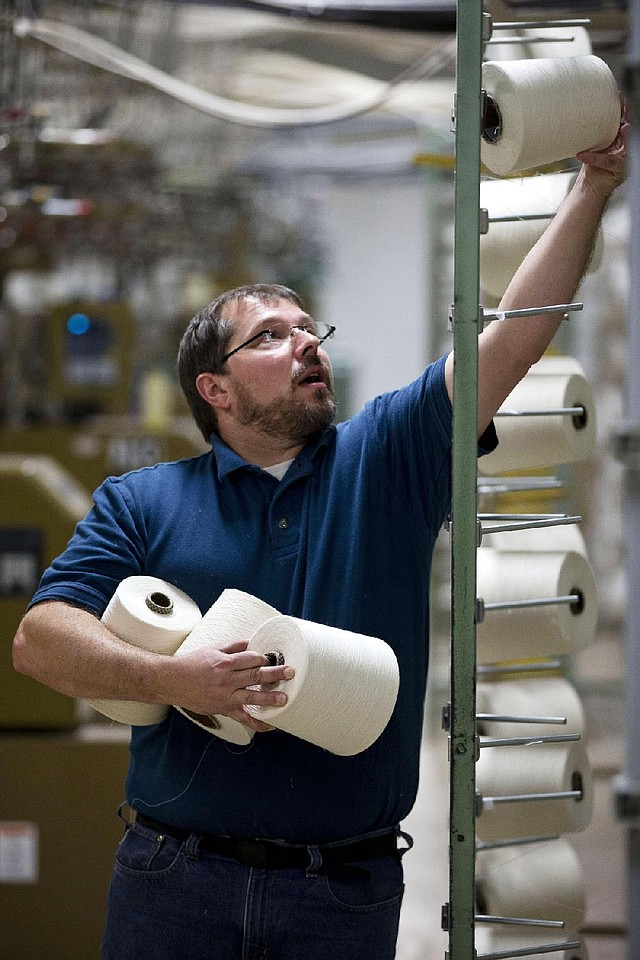Trade deficit widens 4.8% to $42.2 billion
Wholesalers see stockpiles grow, but sales on decline
Mike Hartman moves spools of thread at FesslerUSA apparel in Orwigsburg, Pa., in October. The U.S. Commerce Department reported Tuesday that wholesale businesses increased stockpiles in October but saw their sales fall, a mixed sign for economic growth.
Wednesday, December 12, 2012
WASHINGTON — The U.S. trade deficit widened in October when exports fell by a larger margin than imports, a sign that slower global growth could weigh on the U.S. economy.
At the same time, U.S. wholesale businesses increased their stockpiles in October but saw their sales fall sharply, a mixed sign for economic growth.
On Tuesday, the Commerce Department said that the trade deficit grew 4.8 percent, hitting $42.2 billion, from September to October.
Exports dropped 3.6 percent to $180.5 billion as sales of commercial aircraft, autos and farm products all declined. However, imports fell 2.1 percent to $222.8 billion, reflecting fewer shipments of cell phones, autos and machinery.
Paul Dales, senior U.S. economist at Capital Economics, said the decline in both exports and imports likely reflected some disruptions from superstorm Sandy. The storm closed ports in the Northeast for the last few days of October. Exports should rebound in November, Dales said, but he expects the longer-run trend to stay negative.
“The bigger issue is that the weak global economy has been taking its toll on exports,” Dales said, predicting trade would drag slightly on overall U.S. growth in 2013.
The U.S. trade gap with China also increased to a record high. President Barack Obama’s administration has heard complaints from manufacturers and U.S. lawmakers about allegations of China’s use of unfair trade practices.
A wider trade deficit acts as a drag on U.S. growth. It typically means the U.S. is earning less on overseas sales of American-produced goods while spending more on foreign products.
Also Tuesday, the Commerce Department said stockpiles grew 0.6 percent in October — slower than September’s 1.1 percent increase, which was the biggest gain in nine months. Sales in October fell 1.2 percent, after rising 1.9 percent in September.
With the October increase, wholesale inventories grew to $497.1 billion. That’s 29.2 percent above the postrecession low hit in September 2009.
More restocking leads to more factory production, which boosts economic growth. Faster restocking was a key reason the economy grew from July through September at an annual rate of 2.7 percent.
Still, slower October sales could force companies to cut back on restocking in coming months. That could hold back growth in the October-December quarter.
Businesses and consumers may be cutting back on spending because they are worried about the “fiscal cliff,” a package of tax increases and government spending cuts that will take effect next year unless Congress and the Obama administration strike a deal before then to avert them.
Consumer spending slowed slightly in the July-September quarter and may show only modest gains in the final three months of the year.
Exports rose to a record high in September, which also helped lift economic growth in the July-September quarter — more than double the 1.3 percent annual growth rate in the April-June quarter.
Many economists say growth is slowing in the current October-December quarter to less than 2 percent. One reason for the weaker growth is the decline in exports. And U.S. companies are probably cutting back on restocking, mostly because of worries about looming tax increases and government spending cuts that will kick in next year without a budget deal before January.
There were some hopeful signs in the report.
U.S. exports to the 27-nation European Union rose 1.4 percent in October. Exports to that region have fallen 0.7 percent from January through October because the debt crisis has pushed many European nations into recession.
The United States also ran a record $2.6 billion trade surplus in October with the nations of South and Central America. The surplus with Brazil, the largest economy in South America, was $1.8 billion. U.S. exports to that country hit a record $4.1 billion.
Still, the U.S. trade deficit with China kept growing in October to a record $29.5 billion.
American manufacturers say China has kept the yuan undervalued against the U.S. dollar. A lower valued yuan makes Chinese goods cheaper for U.S. consumers and American products more expensive in China.
The Obama administration has lobbied China to move more quickly to allow the yuan to rise in value. But it has refused to cite China as a currency manipulator. That designation would require negotiations between the two nations and could lead to the United States filing a trade case against China before the World Trade Organization.
Business, Pages 25 on 12/12/2012
